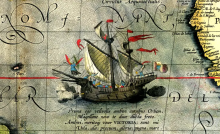This week on Portsmouth Point: Magellan: At World's End

Magellan: At World's End by Max B, Year 12
It's early September 1522; a battered ship limps into the Spanish port of Sanlúcar de Barrameda. On board are 18 survivors, remnants of a crew that began at over 270. Their captain, Ferdinand Magellan, was not among them. Yet, history would remember him as the first man to circumnavigate the globe. Ferdinand Magellan was a visionary, driven by deep-rooted ambition and faith in his own navigational theories. He began the world's first circumnavigation but tragically died halfway. Although Magellan didn’t live, his expedition reshaped global understanding of geography, trade, and empire.
Born in Sarbosa (Portugal) in around 1480, Magellan was orphaned at a young age, becoming a page at the court of Queen Leonor. As a young boy, he studied astronomy, cartography, navigation, and Latin, all skills that would prove vital for his later expeditions. He served in India and the Malay Archipelago as a young man, fighting for portugal at the Battle of Diu in 1509 and becoming involved in trade and military operations in Malacca (modern-day Malaysia.) The early experiences of Magellan in Asia seeded his later ambition to reach the Spice Islands; yet, Portuguese King Manuel I repeatedly denied his proposals for further exploration of the region.
It was in 1517 when Magellan renounced his Portuguese citizenship and travelled to Spain. Independent of his former nation, he partnered with Rui Faleiro, a cosmographer, to draw up a westward route to the Spice Islands. Unlike his Portuguese counterpart, King Charles I of Spain supported the plans, approving the expedition in 1518 and seizing a chance to challenge the trade dominance of the Portuguese. Magellan was appointed captain-general on September 15, 1519; he was promised 1/20th of the profits and governorship of any lands he discovered.
September 1519, a fleet of five ships departs from Seville, led by flagship Trinidad. Sailing with them, 270 men of various European origins, and commanding them all, Magellan. However, despite his appointment as captain, Magellan faced tensions with Spanish captains aboard who resented him as a Portuguese leading a Spanish fleet. The expedition had a rocky start, with a rough crossing of the Atlantic prompting stopovers at the Canary Islands and Brazil. The fleet reached Rio de la Plata, continuing their search down the South American coast for a westward strait.
The fleet emerges from an overwintering at Puerto San Julián in South Argentina, having made little to no real progress. The expedition is nearing 7 months old, and the same tensions that were present at the beginning of the voyage reach boiling point. It was April 15, 1520 when Spanish captains Gaspar de Quesada and Luis de Mendoza decided it was time for them to act. They mutiny, yet Magellan suppresses them with considerable force, executing Quesada, stabbing Mendoza, and marooning others who stood with them.
Closely following the mutiny, the fleet lost one of their ships, Santiago, which was shipwrecked during a scouting mission. Morale quickly plummeted, and starvation, bolstered by the cold, took its toll on the crew.
However, things seemed to be looking up for the remaining 4 ships and their crew in October 1520, when they found a narrow passage, now known as the Strait of Magellan, enabling the crew to sail through Argentina and enter the Pacific. Yet, this amazing discovery was overshadowed by the fact that the passage contained 600km of treacherous channels, rocks, and cold winds. This provoked the crew of the ship San Antonio to betray the mission, fleeing back to Spain.
Reaching the Pacific, or “Mar Pacifico” as the Spaniards labelled it, the 3 ships spent over three months crossing the Pacific, unaware of its vastness. Hit by scurvy and starvation, the crew had to resort to eating rats and sawdust. Again, the fleet somehow survived and reached the Philippines on March 1521.
The expedition spent some time in the region, converting local leaders to Christianity and attempting to impose Spanish dominance over the area. On April 15, 1521, Magellan intervened in a local conflict against natives on Mactan Island. But the attack was poorly planned; tidal issues combined with an underestimated native saw an embarrassing defeat for the Spanish, with Magellan violently killed in battle. The death of Ferdinand Magellan marked a distinct turning point on the voyage; the mission changed from a glorious conquest to a struggle for survival.
The ships continued westward to the Spice Islands and loaded up on cloves and other spices. They then sailed towards Spain, avoiding the ports of the Portuguese, reaching Spanish land in September 1522, 3 years after they departed. Yet, in those three years, the expedition had sailed 42,000 miles, lost 252 men, 4 ships, and their captain.
Despite his death, Ferdinand Magellan was the man to prove that the globe was round and connected by water; he established the size of the Pacific and the scope of the Earth; he improved European knowledge of global wind systems, ocean currents, and world geography. Magellan and his expedition boosted Spanish maritime prestige and opened the Pacific to future colonisation. Magellan may be viewed as a hero in the west, but he remains a villain in the Philippines; he was criticised for violence and colonial ambitions. Yet, despite criticism, achievements precede him.
Ferdinand Magellan set out to circle the Earth; although he never lived to see his vision come to fruition, his courage, ambition, and obsession left a permanent mark on global history. Magellan's legacy remains complex: a visionary navigator, imperial agent, and controversial Portuguese outcast who led a Spanish fleet to the end of the earth.


















.png&command_2=resize&height_2=85)



